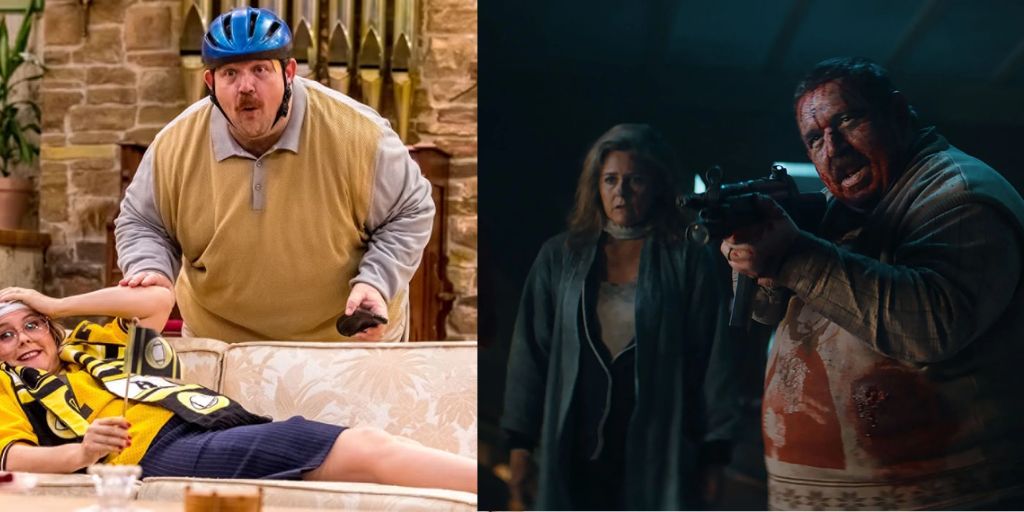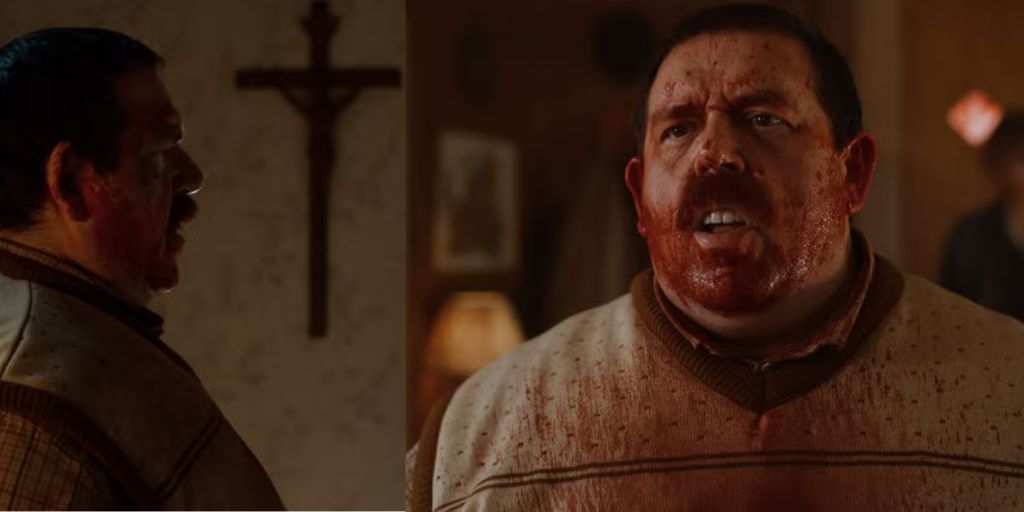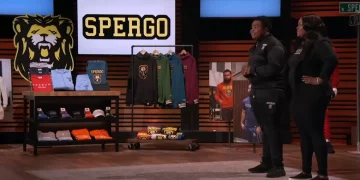Filmmaking is a field that requires a lot of creativity, experimentation, and, above all, a clear vision. Directors often try new ideas to push boundaries and engage audiences.
However, not every experiment turns out well. One recent film that exemplifies this is Krazy House, directed by Steffen Haars and Flip van der Kuil.
This Dutch action-horror comedy was supposed to be a unique and entertaining addition to the genre. Instead, it stands out as a major failure.
What could have been a fun and engaging short film became a long, painful viewing experience that left audiences confused and disappointed.
The film’s concept revolves around blending comedy with horror, drawing inspiration from various sources, including popular sitcoms from the 1990s.
The filmmakers aim to roast these shows, taking familiar tropes and turning them on their heads. Unfortunately, the execution falls short.
Krazy House tries to tackle heavy themes, such as religious zealotry and family dynamics, but does so without any real depth or clarity. Instead, viewers are treated to a disjointed narrative filled with cringe-worthy jokes, absurd situations, and a lack of coherence.
The Premise
Krazy House stars Nick Frost as Bernard “Bernie” Christian, an obsessively religious stay-at-home father. He wears self-knitted sweaters adorned with Christian symbols and believes deeply in living according to God’s rules.
This character is the central figure in a sitcom also called Krazy House, which the film presents in a way that mimics watching a television program from our childhoods. This concept offers a nostalgic feel, but it quickly devolves into chaos.
Bernie’s family consists of his wife, Eva, played by Alicia Silverstone, their daughter Sarah, portrayed by Gaite Jansen, and their son Adam, played by Walt Klink.
Eva works a vague corporate job, while Sarah is desperate for a boyfriend. Adam has chosen science over religious beliefs, setting up a clash of values within the household.
This family dynamic serves as the basis for the film’s comedy, echoing the lessons and humor found in classic sitcoms like Family Matters and Full House.
Bernie’s character embodies the humorous yet earnest traits of sitcom protagonists, complete with his own catchphrase: “Oh gosh, what a mess!” However, the humor feels forced, and the character’s naiveté quickly becomes grating rather than endearing.
Main Conflicts and Humor
The central conflicts in Krazy House arise from Bernie’s inability to effectively support and empower his family. The film attempts to create humor through Bernie’s absurd ideas and interactions with his family.
For instance, there are moments where his wife tries to accommodate his bizarre “invention” of attaching scrubbing brushes to his shoes. These moments are meant to be humorous but often come off as awkward and unoriginal.
Another source of humor stems from Adam’s mockery of his father’s faith. Bernie often responds to Adam’s skepticism with Bible verses, creating a comedic tension.
However, this humor falls flat, especially when the narrative shifts dramatically with the sudden arrival of Russian workers. These moments seem disjointed and lack the finesse needed to create a cohesive comedic experience.
As the film progresses, Bernie inadvertently destroys his family’s kitchen, setting the stage for the unexpected arrival of a trio of Eastern European workers. This sudden shift in tone is jarring and feels out of place within the established narrative.
Pjotr, played by Jan Bijvoet, along with his sons Dmitri and Igor, played by Chris Peters and Matti Stooker, respectively, begin demolishing Bernie’s house without any resistance from him. This situation further emphasizes Bernie’s passive nature and inability to protect his family.
Misguided Satire
One of the film’s significant missteps is its attempt to use satire. Haars and Kuil appear to confuse absurdity and stupidity, mistaking the latter for effective satire. Nick Frost’s performance, particularly his American accent, comes across as forced and distracts from the story.
While the filmmakers aim for a comedic critique of family sitcoms, they fail to deliver anything of substance. The set design draws inspiration from iconic sitcoms like Married With Children and Everybody Loves Raymond, but the humor is ten times sillier than anything those shows presented.
Haars and Kuil’s portrayal of sitcoms as silly and absurd may have potential, but it quickly deteriorates into an incoherent narrative.
The film’s humor, rather than being sharp and insightful, becomes a nonsensical collection of jokes that do not land. Frost’s portrayal of Bernie becomes a comedic black hole, pulling the humor into a void of confusion and discomfort.
Tone and Pacing Issues
The tonal shifts in Krazy House are abrupt and confusing. The film starts with a light-hearted, if not somewhat ridiculous, premise.
However, it quickly transitions into a dark and chaotic environment that leaves viewers disoriented. Haars and Kuil attempt to inject shocking elements into the film, hoping to elicit strong reactions from the audience. However, the lack of balance makes the storytelling feel reckless and disjointed.
Early scenes feature subliminal shots of a bloodied Bernie, teasing viewers about the chaos that is to follow. While this could have been a clever storytelling device, it instead feels like an attempt to manipulate audience expectations without any real payoff.
The filmmakers seem to aim for a shock factor akin to Adult Swim’s more experimental programming, but they do not possess a compelling story to justify their aggressive approach. Instead, viewers are left with a string of confusing events that fail to connect.

Failure to Establish a Coherent Story
One of the most significant issues with Krazy House is its inability to establish a coherent and engaging storyline. The film lacks direction and clarity, leaving audiences frustrated and confused.
As the narrative progresses, it becomes increasingly challenging to follow the characters’ motivations and the overall plot. The comedy fails to feel organic, and the absurdity of the situations overshadows any potential for genuine humor.
The introduction of the Russian workers adds a layer of chaos, but it does not contribute meaningfully to the story. Instead, it feels like a forced attempt to inject tension and conflict.
The film’s reliance on shock value rather than coherent storytelling is detrimental to its overall effectiveness. As the audience, we are left wondering what the filmmakers were trying to convey and whether they had any real message to share.
Poor Execution of Themes
Krazy House also attempts to tackle heavier themes, such as the conflict between faith and science and the struggles of modern family life.
However, these themes are executed poorly and lack depth. Instead of engaging with these complex ideas, the filmmakers settle for shock tactics and exaggerated humor. The result is a film that feels shallow and unfulfilled.
While there are chances of potential within the character dynamics and family conflicts, these elements are overshadowed by the film’s chaotic tone and lack of focus.
The moments that could have been meaningful are instead lost in a barrage of absurdity. The film ultimately fails to provide any real commentary on the issues it seeks to address.
Missteps in Humor and Satire
The humor in Krazy House often misses the mark. The filmmakers aim for satire but end up relying on tired jokes and clichés that fail to resonate with audiences.
The comedic moments that are supposed to highlight the absurdity of sitcoms instead come off as forced and unoriginal. The film’s reliance on shock value over clever humor only serves to alienate viewers.
The filmmakers attempt to play with the audience’s expectations by presenting a familiar format only to subvert it in increasingly bizarre ways.
However, this approach feels more like a desperate attempt to be edgy rather than a thoughtful critique of the genre. The humor lacks the necessary wit and insight to make it effective, resulting in a disjointed viewing experience.
The film’s characters, particularly Bernie, lack the depth and development needed to engage viewers. Nick Frost’s portrayal of Bernie is meant to be humorous and relatable, but instead, it feels one-dimensional.
The character’s obsessive religiosity comes across as a mere gimmick rather than a meaningful aspect of his personality. This lack of character development makes it challenging for audiences to invest in the story.
The other family members, while providing some comedic moments, also lack depth. Eva’s corporate job is vague, and her character does not grow throughout the film.
Sarah’s desperation for a boyfriend becomes a running joke rather than a meaningful subplot. Adam’s choice to pursue science over faith is briefly mentioned but not covered in any meaningful way.
The introduction of the Russian workers further complicates the character dynamics without adding any real depth.
Pjotr and his sons serve as chaotic forces in the film, but they lack individual personalities or motivations. As a result, the film feels crowded with characters who do not contribute to a coherent narrative.

Chaotic and Confusing Structure
The overall structure of Krazy House is chaotic and confusing. The filmmakers throw a series of random events at the audience without establishing a clear connection between them. This lack of coherence makes it difficult for viewers to follow the story, leading to frustration rather than amusement.
As the film progresses, it becomes apparent that Haars and Kuil are more interested in shocking their audience than in creating a cohesive narrative.
The chaotic structure ultimately detracts from any potential message the film might have had. Instead of a meaningful exploration of family dynamics or societal norms, viewers are left with a disjointed series of events that feel hollow.
Krazy House stands as a prime example of a film that fails to deliver on its ambitious premise. While the concept of blending comedy and horror holds potential, the execution falls flat.
The film’s disjointed narrative, lack of character development, and misguided humor result in a viewing experience that is more painful than enjoyable.
Haars and Kuil’s attempt to critique family sitcoms and find heavier themes ultimately lacks the depth and coherence necessary for a successful film.
Rather than engaging audiences, Krazy House leaves them bewildered and unsatisfied. While experimentation is essential in filmmaking, it is equally important to maintain a clear vision and direction.
In the end, Krazy House serves as a cautionary tale for filmmakers looking to push boundaries. Creativity and innovation are important, but without a solid foundation, even the most ambitious ideas can falter.
For audiences, this film is best approached with caution, as it represents a misguided attempt to blend genres in a way that fails to resonate. While there may be moments of potential, they are overshadowed by the film’s chaotic execution, leaving viewers wondering what went wrong.
In reflecting on Krazy House, it becomes evident that the film’s failure lies not just in its execution but also in its overall approach to storytelling.
The filmmakers, Steffen Haars and Flip van der Kuil, seemed to have a vision that could have resulted in a clever and entertaining film, yet they allowed the chaotic structure and forced humor to overshadow their intentions.
One important aspect that the film neglects is the opportunity for character growth and development. The potential for exploring the complexities of family relationships and individual beliefs exists within the narrative framework but is never fully realized.
Bernie’s journey, which could have been a poignant exploration of faith clashing with modern values, instead turns into a series of poorly executed gags. This lack of depth extends to the supporting characters, whose stories remain largely hidden, leaving the audience without relatable connections or emotional investment.
Moreover, the tonal inconsistencies detract from any message the filmmakers might have hoped to convey. The sudden shifts from light-hearted comedy to dark and chaotic scenarios create a disjointed viewing experience that feels more jarring than engaging.
This haphazard approach ultimately undermines the film’s ability to resonate with its audience. Viewers may find themselves questioning the film’s intentions rather than enjoying the absurdity of the situations presented.
The attempt to satirize familiar sitcom tropes is commendable in theory but fails in practice due to the reliance on shock value rather than genuine humor.
The filmmakers miss the mark in providing a thoughtful critique of family dynamics and societal norms, resulting in a film that feels empty rather than insightful.
This misstep serves as a reminder that satire requires careful consideration and sharp wit to be effective, neither of which are present in Krazy House.
Krazy House is a film that represents a series of missed opportunities. The ambition to blend comedy and horror within the framework of a family sitcom is commendable, but the lack of coherence, depth, and engaging storytelling ultimately leads to a disappointing experience.
For aspiring filmmakers, this film serves as a cautionary tale about the importance of a clear vision, strong character development, and a coherent narrative structure. It highlights that creativity should be balanced with substance to create a film that resonates with audiences.
While the concept may have shown promise, the final product is a convoluted mess that fails to deliver any meaningful commentary, leaving viewers with more questions than answers.
As a result, Krazy House stands as an example of what can happen when ambition outpaces execution, and it will likely be remembered as a cautionary tale in the domain of contemporary cinema.





